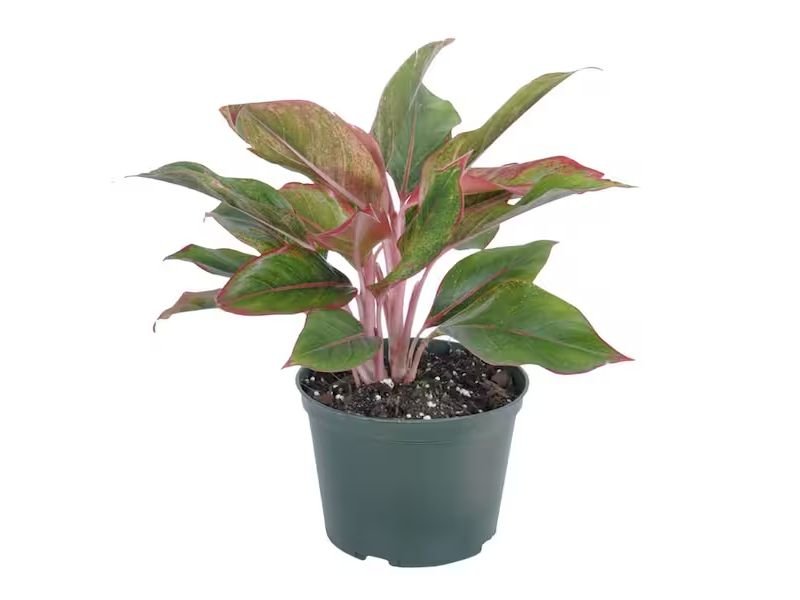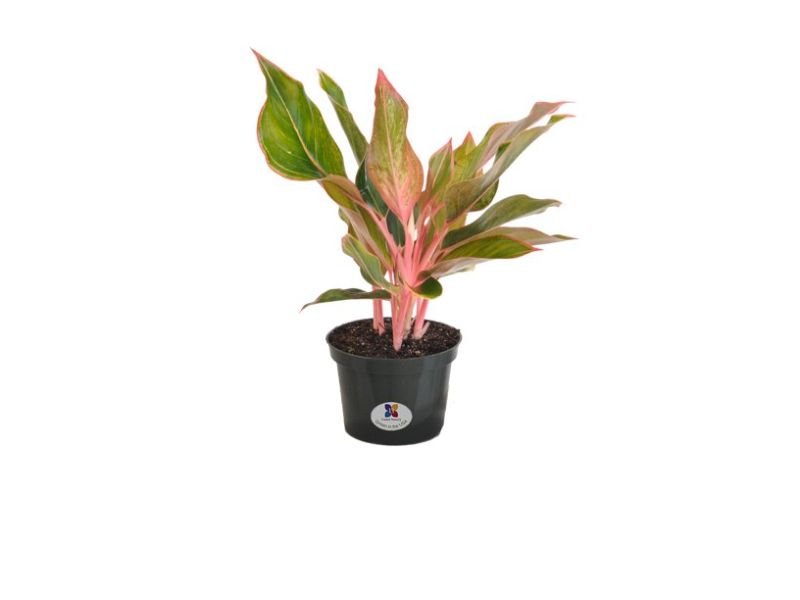Aglaonema Sapphire Suzanne is an eye-catching indoor plant that has gained immense popularity in recent years. This plant belongs to the genus Aglaonema, which has over 20 species of flowering plants native to Southeast Asia. Aglaonema Sapphire Suzanne is a hybrid plant that originated from the cross-breeding of two different species of Aglaonema.

Table of Contents
Definition of Aglaonema Sapphire Suzanne
Aglaonema Sapphire Suzanne is a unique and rare indoor plant known for its striking foliage and easy maintenance. It is a tropical evergreen perennial plant that can grow up to three feet tall and wide, with leaves that feature attractive variegation. The leaves are usually lance-shaped or oval, with a glossy texture and thick texture.
Brief history and origin of the plant
The history of Aglaonema Sapphire Suzanne can be traced back to the late 19th century when botanists first discovered the Aglaonema genus in Southeast Asia. The hybridization process started in the early 1950s when breeders experimented with different varieties of Aglaonema plants, including Red Gold, Silver Queen, and Golden Bay.
The breeding process led to the creation of new cultivars with unique features such as variegated leaves, compact growth habits, and increased disease resistance. One such cultivar was named ‘Sapphire’, which had attractive blue-green foliage with silver markings.
Later on, ‘Suzanne’ was introduced as a sport mutation that had wider stripes than its parent variety. In 2018, these two cultivars were crossed by Thai breeder Pachara Orchids & Plants under license from University Putra Malaysia (UPM), giving birth to this hybrid – Aglaonema Sapphire Suzanne.
Importance and popularity of the plant
Aglaonema Sapphire Suzanne is a popular houseplant due to its unique and striking appearance, making it a favorite among plant collectors and enthusiasts. Its attractive foliage makes it an excellent choice for indoor gardening, where it can be used as a decorative accent or focal point in any room.
The plant’s easy maintenance requirements make it perfect for those new to indoor gardening or those with busy lifestyles who don’t have much time to devote to plant care. Moreover, Aglaonema Sapphire Suzanne is an excellent air purifier that can help improve indoor air quality by removing harmful toxins and pollutants from the air.
It is also known to reduce stress and boost productivity, making it an ideal addition to homes, offices, and other indoor spaces. Overall, this hybrid has quickly become one of the most sought-after Aglaonema varieties in the world due to its unique features and ease of care.
Description of Aglaonema Sapphire Suzanne

Physical Appearance and Characteristics
Aglaonema Sapphire Suzanne is a beautiful and exotic plant that belongs to the Araceae family. It is known for its striking foliage that comes in various shades of green, silver, and blue.
The leaves are glossy with a leathery texture, shaped like an elongated oval with a pointed tip. They can grow up to 12 inches long and 4 inches wide, making them quite substantial in size.
Leaf Color and Shape
The most notable feature of the Aglaonema Sapphire Suzanne is its unique leaf coloration. The large elliptic leaves have an iridescent sheen that resembles a sapphire gemstone. The edges of the leaves are adorned with vibrant silver markings, creating an attractive contrast between the blue-green base color and the silver-white accents.
Size and Growth Habit
Aglaonema Sapphire Suzanne has an upright growth habit, reaching up to 2 feet tall when mature depending on the variety you choose. The plant has numerous stems that emerge from underground rhizomes, making it look bushy as it grows older.
Unique Features that Distinguish it from Other Plants
One unique feature of Aglaonema Sapphire Suzanne is its ability to purify indoor air by filtering toxins such as benzene, formaldehyde, and other harmful chemicals found in furniture polish or cleaning products. Another unique aspect is its adaptability to low light conditions which makes it perfect for indoor planting or workspaces where natural light isn’t abundant.
Varieties of Aglaonema Sapphire Suzanne
There are several varieties of Aglaonema Sapphire Suzanne available in the market today each having distinct features such as different leaf patterns and colors such as Silver Bay has a silver center and green edges, it also grows wider compared to the other varieties. The Maria variety is smaller in size with a more compact growth habit and has striking pink variegation on its leaves.
Overall, Aglaonema Sapphire Suzanne is an exquisite plant that is sure to make a statement in any living space or workspace. Its unique characteristics make it stand out from other houseplants, and its adaptability makes it easy to care for even for those inexperienced at plant care.
How to Care for Aglaonema Sapphire Suzanne
Light requirements: Optimizing Growth and Avoiding Damage
Aglaonema Sapphire Suzanne thrives in medium to low light conditions, making it a perfect choice for areas with limited natural light. However, it is crucial to provide the plant with enough light to ensure growth and prevent damage caused by too little or too much light.
To optimize growth, place the plant in a well-lit area that has bright but indirect sunlight. Direct sunlight can scorch the leaves while insufficient light can cause stunted growth or yellowing of leaves.
If you are unsure whether your plant is getting enough light, check the soil for dryness. If it’s dry, your plant probably needs more water and light.
On the other hand, if your plant is getting too much direct sunlight, you’ll notice that its leaves will start turning brown on the edges or curl up into themselves. Fortunately, this type of damage is reversible by moving your Aglaonema Sapphire Suzanne to a more shaded area.
Watering Needs: Keeping Your Plant Hydrated But Not Overwatered
As a tropical plant originally from Asia, Aglaonema Sapphire Suzanne requires high humidity levels and consistent moisture content in its soil. However, overwatering can lead to root rot and other water-related damage.
The general rule of thumb is to water your Aglaonema Sapphire Suzanne when the top inch of the soil feels dry to the touch. To keep the moisture level consistent between watering sessions without risking over-watering, consider using a well-draining potting mix that allows excess water to drain off quickly.
It’s also important not to let your plant sit in standing water as this can lead to root rot or other fungal infections. A simple trick is using a saucer under your container and emptying any excess water after 20 minutes.
Soil Requirements: The Type and Quality of Soil for Aglaonema Sapphire Suzanne
Aglaonema Sapphire Suzanne grows well in a well-draining soil mix that retains moisture while allowing excess water to drain. The ideal soil mix should have a pH between 5.5 to 6.5 and be rich in organic matter like peat moss. It is crucial to ensure that the soil quality remains high, as this determines how healthy your Aglaonema Sapphire Suzanne will grow.
High-quality soil will provide your plant with enough nutrients, improve its overall health, and help prevent disease or pest infestation. If you notice that your plant is struggling despite getting enough light and water, consider repotting it or amending the soil with more organic matter like compost, mulch, or perlite.
Temperature and Humidity Requirements: Creating Ideal Growing Conditions
Aglaonema Sapphire Suzanne thrives in temperatures between 65-80°F (18-26°C) during the day and above 50°F (10°C) at night. These tropical plants also require high humidity levels ranging from 50% to 80%.
To maintain optimal humidity levels around your Aglaonema Sapphire Suzanne, consider placing it near other plants or using a humidifier. If you live in an area with dry air or low humidity levels indoors, you might need to mist your plant regularly or place a tray of water underneath it.
However, take care not to over-mist as this can lead to fungal growth on the leaves. By Aglaonema Sapphire Suzanne’s ideal growing conditions such as watering it right, and keeping its soil quality high while protecting it from extreme light exposure and temperature variations prove helpful in doing all we can for our green friends’ growth!
Rarity and Price
The Rarity of Aglaonema Sapphire Suzanne
Aglaonema Sapphire Suzanne is considered to be a rare plant due to its unique coloration and pattern. It is a hybrid cultivar that was created by crossing two different species of plants, which makes it difficult to find in the market.
Additionally, this plant is slow-growing, which further adds to its rarity. It takes several years for the plant to reach maturity and achieve its full potential, making it a long-term investment for any collector.
The Price of Aglaonema Sapphire Suzanne
Due to its rarity and unique beauty, Aglaonema Sapphire Suzanne can be quite expensive compared to other common houseplants. The price may vary depending on the size of the plant, but it can range anywhere from $50 up to $300 or more for larger specimens. The price also depends on where you purchase the plant from as some nurseries may charge more than others.
It’s worth noting that investing in a rare plant like Aglaonema Sapphire Suzanne can be considered an investment as well as an aesthetic addition to your collection. As long as you take care of it properly, it can last for many years and potentially increase in value over time.
Conclusion
Aglaonema Sapphire Suzanne is a beautiful and rare plant that requires specific care instructions but provides immense rewards with proper maintenance. It’s unique coloring and slow growth rate makes this cultivar highly sought-after among collectors worldwide.
While purchasing such a rare specimen may come with a higher price tag than other common houseplants, keeping one healthy can be considered an investment with potential returns. Investing time into learning about this fascinating cultivar’s needs will lead not only to healthier plants but also create an appreciation for nature’s beauty in all her varied forms from every corner of the globe.

Gardening is my passion and growing plants indoors has always been a stress relief for me. Grow a banana tree in my apartment once (although failed to produce bananas).






